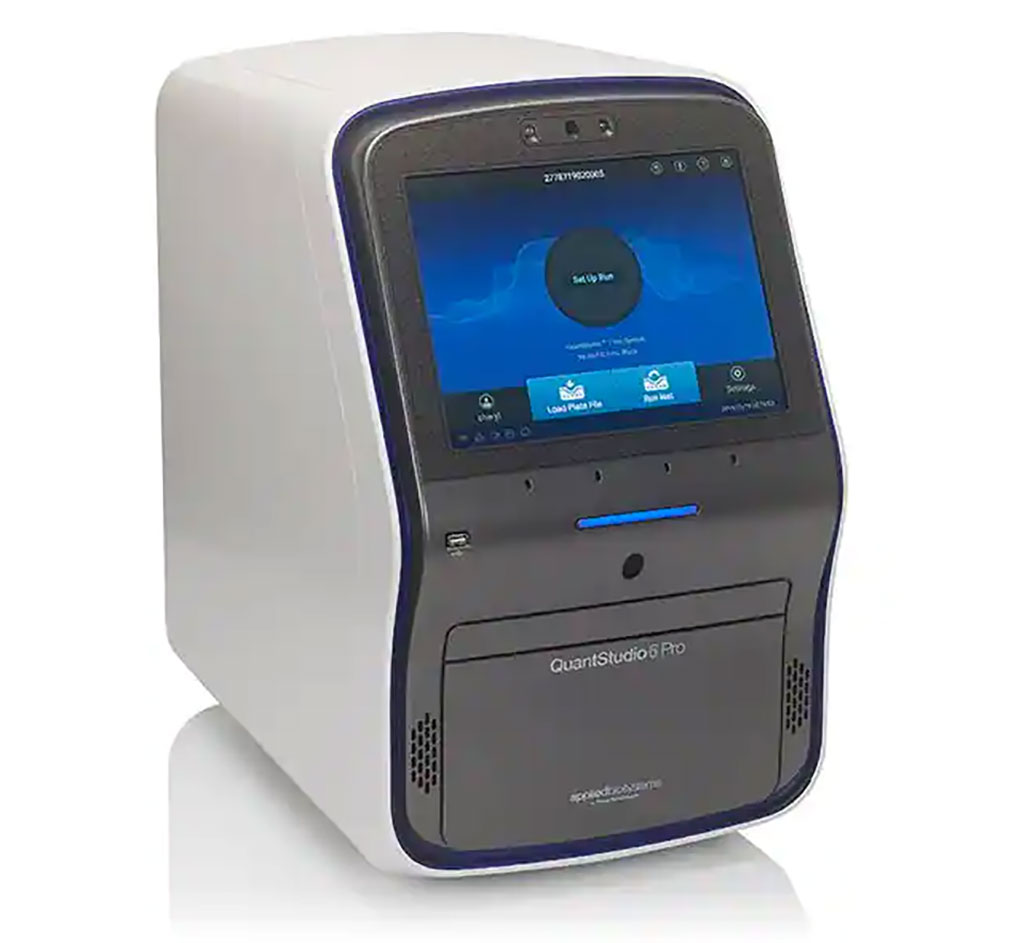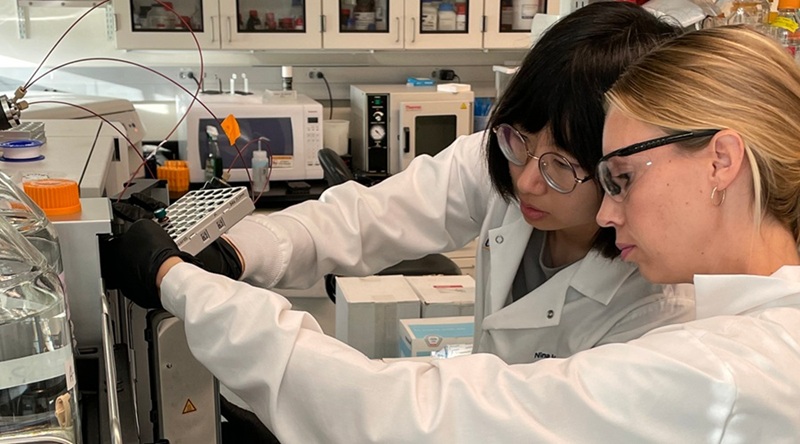Direct Real-Time PCR Protocol Detects Monkeypox Virus
|
By LabMedica International staff writers Posted on 16 Nov 2022 |

Monkeypox virus, an encapsulated double-stranded DNA virus and member of the Poxviridae family, is responsible for the recent monkeypox outbreak that has been declared a public health emergency of international concern.
Prompt identification of infected individuals followed by contact tracing is important for stemming the spread of disease. The characteristic rash of monkeypox progresses through multiple stages, beginning with a macular phase, progressing through papular, vesicular, and pustular phases, and ending with a scab phase.
Clinical Pathologists at the Feinberg School of Medicine (Chicago, IL, USA) collected clinical specimens from patients at locations within the Northwestern Medicine health system. Lesions were swabbed with sterile synthetic swabs, and the swabs were submitted to the laboratory dry or in 3 mL of viral transport media (M4 VTM). Dry swabs received by the laboratory were immediately added to 3 mL of M4 VTM. At the start of the monkeypox outbreak, a total of 20 samples identified as positive by the direct assay and 20 samples identified as negative by the direct assay were sequentially chosen for confirmation by indirect method. DNA extraction for the indirect method was performed using the Qiagen manual DNA extraction kit utilizing spin-column–based nucleic acid purification (Qiagen, Germantown MD, USA).
A modified multiplex version of the CDC monkeypox assay was performed for clinical validation purposes. Previously published probe and primers targeting monkeypox were used. After processing, this was followed by real-time PCR on the Quant Studio 6 instrument (Thermo Fisher Scientific, Waltham, MA, USA). Cycling conditions included a 20-second activation step at 95 °C, followed by 40 cycles of 3 seconds at 95 °C and 30 seconds at 60°C.
The investigators generated a standard curve was by diluting plasmid monkeypox control DNA to concentrations ranging from 1 to 1,000,000 copies/mL and determining the corresponding CT value. The assay displayed excellent linearity (R2 = 0.9994). The limit of detection was determined by replicate determinations of CT values (n = 20) of 5, 50, and 1000 copies/mL samples. The mean CT values of 5 copies/mL were determined to be 36 on both the direct and indirect assay, with an SD of 0.75 (range, 34.61 to 37.39). The analytical specificity was determined by running the assay with control materials for 23 different viruses, bacteria, and fungi. No signal within the limit of detection was detected by the assay in any of the control materials. Blood did have an inhibitory effect on the assay, with increasing concentration of blood leading to greater inhibition. Samples with 20% blood had complete inhibition.
The authors concluded that the validation of a direct method monkeypox assay will allow laboratories to lower costs, reduce dependence on the supply chain for nucleic acid extraction kits, and decrease exposure of laboratory scientists to potentially infectious specimens. In addition, it may be suitable for incorporation into automated and high-throughput testing. This direct method will make it easier for laboratories across the world to rapidly develop, validate, and scale testing for monkeypox virus. The study was published in the November 2022 issue of The Journal of Molecular Diagnostics.
Related Links:
Feinberg School of Medicine
Qiagen
Thermo Fisher Scientific
Latest Microbiology News
- Blood-Based Diagnostic Method Could Identify Pediatric LRTIs
- Rapid Diagnostic Test Matches Gold Standard for Sepsis Detection
- Rapid POC Tuberculosis Test Provides Results Within 15 Minutes
- Rapid Assay Identifies Bloodstream Infection Pathogens Directly from Patient Samples
- Blood-Based Molecular Signatures to Enable Rapid EPTB Diagnosis
- 15-Minute Blood Test Diagnoses Life-Threatening Infections in Children
- High-Throughput Enteric Panels Detect Multiple GI Bacterial Infections from Single Stool Swab Sample
- Fast Noninvasive Bedside Test Uses Sugar Fingerprint to Detect Fungal Infections
- Rapid Sepsis Diagnostic Device to Enable Personalized Critical Care for ICU Patients
- Microfluidic Platform Assesses Neutrophil Function in Sepsis Patients
- New Diagnostic Method Confirms Sepsis Infections Earlier
- New Markers Could Predict Risk of Severe Chlamydia Infection
- Portable Spectroscopy Rapidly and Noninvasively Detects Bacterial Species in Vaginal Fluid
- CRISPR-Based Saliva Test Detects Tuberculosis Directly from Sputum
- Urine-Based Assay Diagnoses Common Lung Infection in Immunocompromised People
- Saliva Test Detects Implant-Related Microbial Risks
Channels
Clinical Chemistry
view channel
Online Tool Detects Drug Exposure Directly from Patient Samples
Doctors often rely on patient interviews and medical records to determine what medications a person has taken, but this information is frequently incomplete. People may forget drugs they used, take over-the-counter... Read more
Chemical Imaging Probe Could Track and Treat Prostate Cancer
Prostate cancer remains a leading cause of illness and death among men, with many patients eventually developing resistance to standard hormone-blocking therapies. These drugs often lose effectiveness... Read moreHematology
view channel
MRD Tests Could Predict Survival in Leukemia Patients
Acute myeloid leukemia is an aggressive blood cancer that disrupts normal blood cell production and often relapses even after intensive treatment. Clinicians currently lack early, reliable markers to predict... Read more
Platelet Activity Blood Test in Middle Age Could Identify Early Alzheimer’s Risk
Early detection of Alzheimer’s disease remains one of the biggest unmet needs in neurology, particularly because the biological changes underlying the disorder begin decades before memory symptoms appear.... Read more
Microvesicles Measurement Could Detect Vascular Injury in Sickle Cell Disease Patients
Assessing disease severity in sickle cell disease (SCD) remains challenging, especially when trying to predict hemolysis, vascular injury, and risk of complications such as vaso-occlusive crises.... Read more
ADLM’s New Coagulation Testing Guidance to Improve Care for Patients on Blood Thinners
Direct oral anticoagulants (DOACs) are one of the most common types of blood thinners. Patients take them to prevent a host of complications that could arise from blood clotting, including stroke, deep... Read moreImmunology
view channel
Routine Blood Test Can Predict Who Benefits Most from CAR T-Cell Therapy
CAR T-cell therapy has transformed treatment for patients with relapsed or treatment-resistant non-Hodgkin lymphoma, but many patients eventually relapse despite an initial response. Clinicians currently... Read more
New Test Distinguishes Vaccine-Induced False Positives from Active HIV Infection
Since HIV was identified in 1983, more than 91 million people have contracted the virus, and over 44 million have died from related causes. Today, nearly 40 million individuals worldwide live with HIV-1,... Read more
Gene Signature Test Predicts Response to Key Breast Cancer Treatment
DK4/6 inhibitors paired with hormone therapy have become a cornerstone treatment for advanced HR+/HER2– breast cancer, slowing tumor growth by blocking key proteins that drive cell division.... Read more
Chip Captures Cancer Cells from Blood to Help Select Right Breast Cancer Treatment
Ductal carcinoma in situ (DCIS) accounts for about a quarter of all breast cancer cases and generally carries a good prognosis. This non-invasive form of the disease may or may not become life-threatening.... Read moreMicrobiology
view channel
Blood-Based Diagnostic Method Could Identify Pediatric LRTIs
Lower-respiratory tract infections (LRTIs) are a leading cause of illness and death worldwide, and pneumonia is the leading infectious cause of death in children under five, claiming the lives of over... Read more
Rapid Diagnostic Test Matches Gold Standard for Sepsis Detection
Sepsis kills 11 million people worldwide every year and generates massive healthcare costs. In the USA and Europe alone, sepsis accounts for USD 100 billion in annual hospitalization expenses.... Read moreRapid POC Tuberculosis Test Provides Results Within 15 Minutes
Tuberculosis remains one of the world’s deadliest infectious diseases, and reducing new cases depends on identifying individuals with latent infection before it progresses. Current diagnostic tools often... Read more
Rapid Assay Identifies Bloodstream Infection Pathogens Directly from Patient Samples
Bloodstream infections in sepsis progress quickly and demand rapid, precise diagnosis. Current blood-culture methods often take one to five days to identify the pathogen, leaving clinicians to treat blindly... Read morePathology
view channel
Rapid Low-Cost Tests Can Prevent Child Deaths from Contaminated Medicinal Syrups
Medicinal syrups contaminated with toxic chemicals have caused the deaths of hundreds of children worldwide, exposing a critical gap in how these products are tested before reaching patients.... Read more
Tumor Signals in Saliva and Blood Enable Non-Invasive Monitoring of Head and Neck Cancer
Head and neck cancers are among the most aggressive malignancies worldwide, with nearly 900,000 new cases diagnosed each year. Monitoring these cancers for recurrence or relapse typically relies on tissue... Read more
Common Health Issues Can Influence New Blood Tests for Alzheimer’s Disease
Blood-based tests for Alzheimer’s disease are transforming diagnosis by offering a simpler alternative to spinal taps and brain imaging. However, many people evaluated at memory clinics also live with... Read more
Blood Test Formula Identifies Chronic Liver Disease Patients with Higher Cancer Risk
Chronic liver disease affects millions worldwide and can progress silently to hepatocellular carcinoma (HCC), one of the deadliest cancers globally. While surveillance guidelines exist for patients with... Read moreTechnology
view channel
Machine Learning Models Diagnose ALS Earlier Through Blood Biomarkers
Amyotrophic lateral sclerosis (ALS) is a rapidly progressive neurodegenerative disease that is notoriously difficult to diagnose in its early stages. Early symptoms often overlap with other neurological... Read more
Artificial Intelligence Model Could Accelerate Rare Disease Diagnosis
Identifying which genetic variants actually cause disease remains one of the biggest challenges in genomic medicine. Each person carries tens of thousands of DNA changes, yet only a few meaningfully alter... Read moreIndustry
view channel
Abbott Acquires Cancer-Screening Company Exact Sciences
Abbott (Abbott Park, IL, USA) has entered into a definitive agreement to acquire Exact Sciences (Madison, WI, USA), enabling it to enter and lead in fast-growing cancer diagnostics segments.... Read more

















